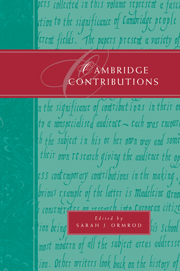Book contents
- Frontmatter
- Contents
- Notes on contributors and contributions
- Preface
- 1 Some Cambridge contributions to astronomy and cosmology
- 2 Cambridge's contribution to medical science
- 3 Cambridge and the study of English
- 4 The Cambridge contribution to economics
- 5 ‘Nasty forward minxes’: Cambridge and the higher education of women
- 6 Cambridge Classics for the third millennium
- 7 Cambridge contributions: the philosophy of science
- 8 European citizenship and education
- 9 The University Botanic Garden
- 10 Geophysics in Cambridge: extinct and active volcanoes
- 11 Cambridge spies: the ‘Magnificent Five’, 1933–1945
5 - ‘Nasty forward minxes’: Cambridge and the higher education of women
Published online by Cambridge University Press: 31 December 2009
- Frontmatter
- Contents
- Notes on contributors and contributions
- Preface
- 1 Some Cambridge contributions to astronomy and cosmology
- 2 Cambridge's contribution to medical science
- 3 Cambridge and the study of English
- 4 The Cambridge contribution to economics
- 5 ‘Nasty forward minxes’: Cambridge and the higher education of women
- 6 Cambridge Classics for the third millennium
- 7 Cambridge contributions: the philosophy of science
- 8 European citizenship and education
- 9 The University Botanic Garden
- 10 Geophysics in Cambridge: extinct and active volcanoes
- 11 Cambridge spies: the ‘Magnificent Five’, 1933–1945
Summary
The theme of this collection of essays is the contribution made by Cambridge. In many fields this translates straightforwardly into an exciting story, an account of distinguished and innovative work in a particular academic discipline, or even the creation of a new one. In the field of women's education the task is not so simple. To ask what Cambridge University has done for women is to evoke a response mostly in the negative. The University resisted the initial arrival of women. When they could no longer be ignored, they were kept at arm's length: such acceptance as there was, was grudging and partial. Cambridge was the last of the old British universities to give full membership to women, waiting until 1948, after the Second World War. Even in the 1990s the proportions of women at every level are somewhat lower than elsewhere in the United Kingdom.
The question of contributions needs turning round: we should instead ask what the women contributed to Cambridge, despite the hostility and all the difficulties. The answers to this are both more positive and more complex. There are contributions within Cambridge to be explored and measured: there are contributions to the wider world of which Cambridge may be proud.
It is a large subject and this essay can serve only as a preliminary sketch. In it I shall focus particularly on the period including the two world wars and the decades between, a period which so far has received much less attention than either the earliest beginnings or the years since 1948, yet one of great importance in the evolution of the two women's colleges as institutions and in their relations with the University.
- Type
- Chapter
- Information
- Cambridge Contributions , pp. 88 - 102Publisher: Cambridge University PressPrint publication year: 1998



